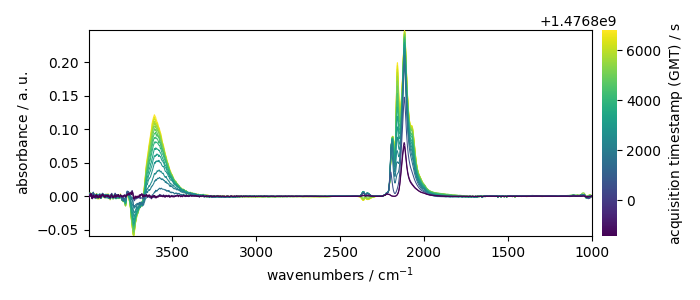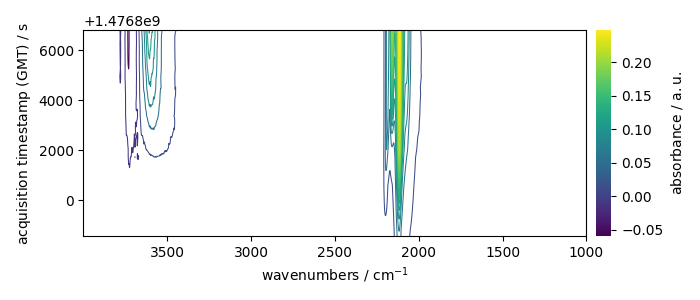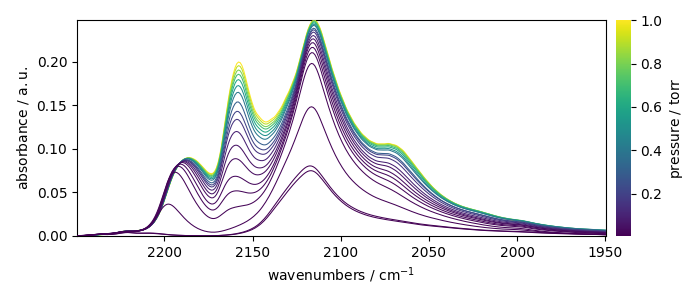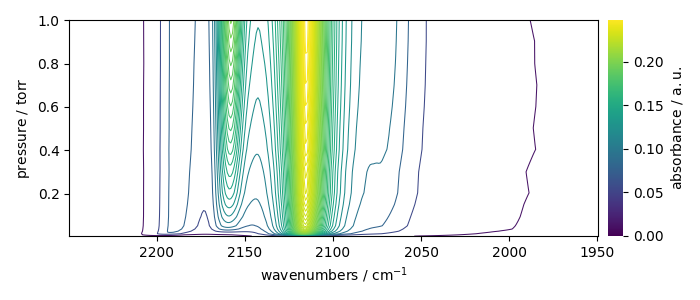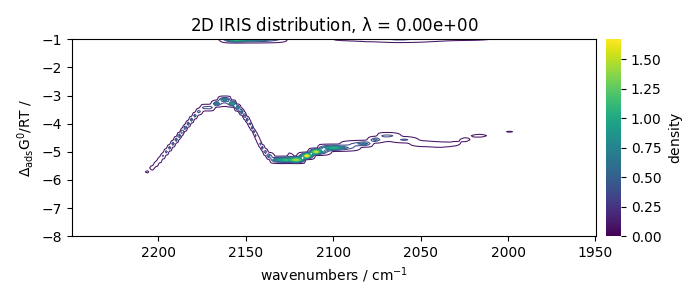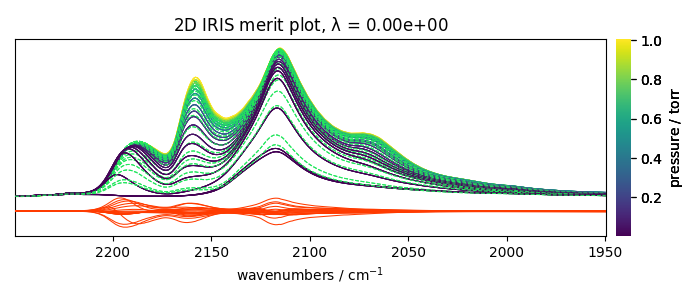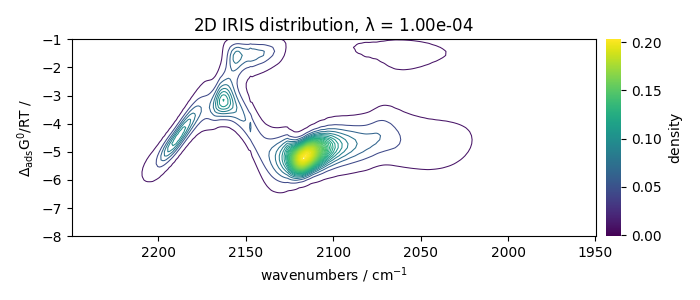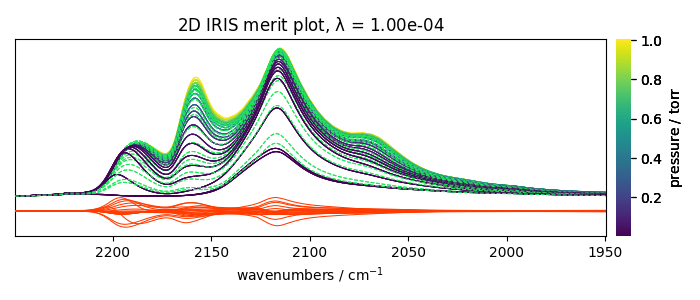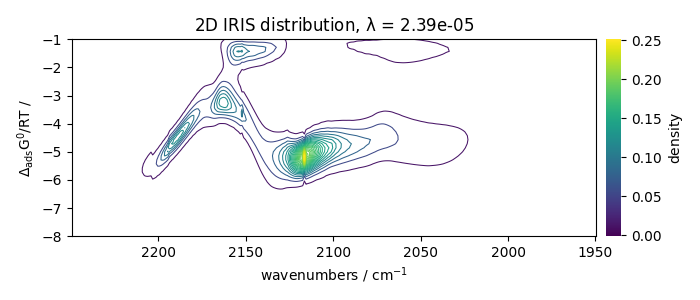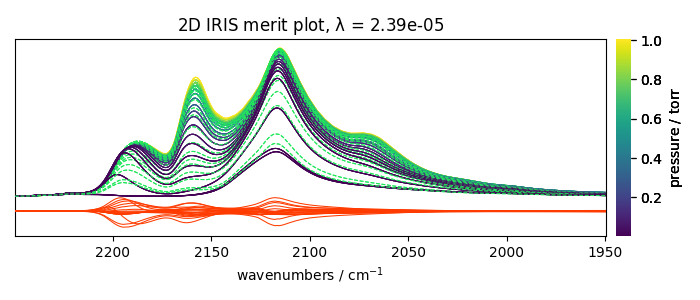Note
Go to the end to download the full example code.
2D-IRIS analysis example
In this example, we perform the 2D IRIS analysis of CO adsorption on a sulfide catalyst.
import spectrochempy as scp
Uploading dataset
X has two coordinates:
* wavenumbers named “x”
* and timestamps (i.e., the time of recording) named “y”.
print(X.coordset)
CoordSet: [x:wavenumbers, y:acquisition timestamp (GMT)]
Setting new coordinates
The y coordinates of the dataset is the acquisition timestamp.
However, each spectrum has been recorded with a given pressure of CO
in the infrared cell.
Hence, it would be interesting to add pressure coordinates to the y dimension:
pressures = [
0.003,
0.004,
0.009,
0.014,
0.021,
0.026,
0.036,
0.051,
0.093,
0.150,
0.203,
0.300,
0.404,
0.503,
0.602,
0.702,
0.801,
0.905,
1.004,
]
c_pressures = scp.Coord(pressures, title="pressure", units="torr")
Now we can set multiple coordinates:
CoordSet: [_1:acquisition timestamp (GMT), _2:pressure]
To get a detailed a rich display of these coordinates. In a jupyter notebook, just type:
By default, the current coordinate is the first one (here c_times ).
For example, it will be used by default for
plotting:
prefs = scp.preferences
prefs.figure.figsize = (7, 3)
X.plot(colorbar=True)
X.plot_map(colorbar=True)
To seamlessly work with the second coordinates (pressures), we can change the default coordinate:
X.y.select(2) # to select coordinate `_2`
X.y.default
Let’s now plot the spectral range of interest. The default coordinate is now used:
X_ = X[:, 2250.0:1950.0]
print(X_.y.default)
X_.plot()
X_.plot_map()
Coord: [float64] torr (size: 19)
IRIS analysis without regularization
Perform IRIS without regularization (the loglevel can be set to INFO to have
information on the running process)
first we compute the kernel object
K = scp.IrisKernel(X_, "langmuir", q=[-8, -1, 50])
Creating Kernel...
Kernel now ready as IrisKernel().kernel!
The actual kernel is given by the kernel attribute
Now we fit the model - we can pass either the Kernel object or the kernel NDDataset
Build S matrix (sharpness)
... done
Solving for 312 channels and 19 observations, no regularization
--> residuals = 1.09e-01 curvature = 9.14e+04
Done.
<spectrochempy.analysis.decomposition.iris.IRIS object at 0x7f9940f11be0>
Plots the results
[<Matplotlib Axes object>]
With regularization and a manual search
Perform IRIS with regularization, manual search
We keep the same kernel object as previously - performs the fit.
iris2.fit(X_, K)
iris2.plotlcurve(title="L curve, manual search")
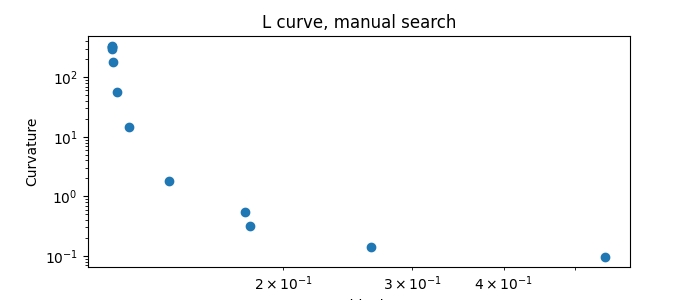
<Axes: title={'center': 'L curve, manual search'}, xlabel='Residuals', ylabel='Curvature'>
Visually, the best regularization parameter is at index ~ -6, corresponding to lambda = 1e-4
[<Matplotlib Axes object>]
Automatic search
%% Now try an automatic search of the regularization parameter around the best value found manually:
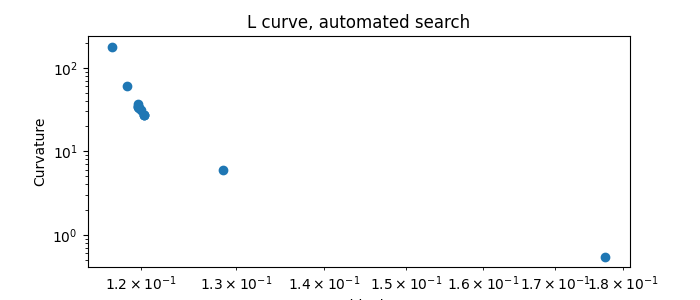
Build S matrix (sharpness)
... done
Solving for 312 channel(s) and 19 observations, search optimum regularization parameter in the range: [10**-6, 10**-2]
Initial Log(lambda) values = [ -6 -4.472 -3.528 -2]
log10(lambda)=-6.000 --> residuals = 1.171e-01 regularization constraint = 1.796e+02
log10(lambda)=-4.472 --> residuals = 1.203e-01 regularization constraint = 2.751e+01
log10(lambda)=-3.528 --> residuals = 1.286e-01 regularization constraint = 5.986e+00
log10(lambda)=-2.000 --> residuals = 1.773e-01 regularization constraint = 5.488e-01
Curvatures of the inner points: C1 = 0.040 ; C2 = 0.105
New range of Log(lambda) values: [ -6 -5.056 -4.472 -3.528]
log10(lambda)=-5.056 --> residuals = 1.186e-01 regularization constraint = 6.040e+01
new curvature: C2 = 0.051
New range (Log lambda):[ -5.056 -4.472 -4.111 -3.528]
log10(lambda)=-4.111 --> residuals = 1.223e-01 regularization constraint = 1.687e+01
Curvatures of the inner points: C1 = 0.054 ; C2 = 0.047
New range of Log(lambda) values: [ -5.056 -4.695 -4.472 -4.111]
log10(lambda)=-4.695 --> residuals = 1.197e-01 regularization constraint = 3.702e+01
new curvature: C2 = 0.091
New range (Log lambda):[ -4.695 -4.472 -4.334 -4.111]
log10(lambda)=-4.334 --> residuals = 1.207e-01 regularization constraint = 2.273e+01
Curvatures of the inner points: C1 = -0.020 ; C2 = 0.272
New range of Log(lambda) values: [ -4.695 -4.557 -4.472 -4.334]
log10(lambda)=-4.557 --> residuals = 1.200e-01 regularization constraint = 3.087e+01
new curvature: C2 = -0.042
New range of Log(lambda) values: [ -4.695 -4.61 -4.557 -4.472]
log10(lambda)=-4.610 --> residuals = 1.198e-01 regularization constraint = 3.330e+01
new curvature: C2 = -0.275
New range of Log(lambda) values: [ -4.695 -4.642 -4.61 -4.557]
log10(lambda)=-4.642 --> residuals = 1.197e-01 regularization constraint = 3.480e+01
new curvature: C2 = 0.234
New range (Log lambda):[ -4.642 -4.61 -4.59 -4.557]
log10(lambda)=-4.590 --> residuals = 1.199e-01 regularization constraint = 3.241e+01
Curvatures of the inner points: C1 = 0.092 ; C2 = 0.440
New range of Log(lambda) values: [ -4.642 -4.622 -4.61 -4.59]
log10(lambda)=-4.622 --> residuals = 1.197e-01 regularization constraint = 3.386e+01
new curvature: C2 = 0.083
New range (Log lambda): [ -4.642 -4.63 -4.622 -4.61]
log10(lambda)=-4.630 --> residuals = 1.197e-01 regularization constraint = 3.422e+01
optimum found: index = 5 ; Log(lambda) = -4.622 ; lambda = 2.38602e-05 ; curvature = 0.092
Done.
<Axes: title={'center': 'L curve, automated search'}, xlabel='Residuals', ylabel='Curvature'>
The data corresponding to the largest curvature of the L-curve are at index 5 of the output data.
[<Matplotlib Axes object>]
This ends the example ! The following line can be uncommented if no plot shows when running the .py script with python
# scp.show()
Total running time of the script: (0 minutes 13.546 seconds)
